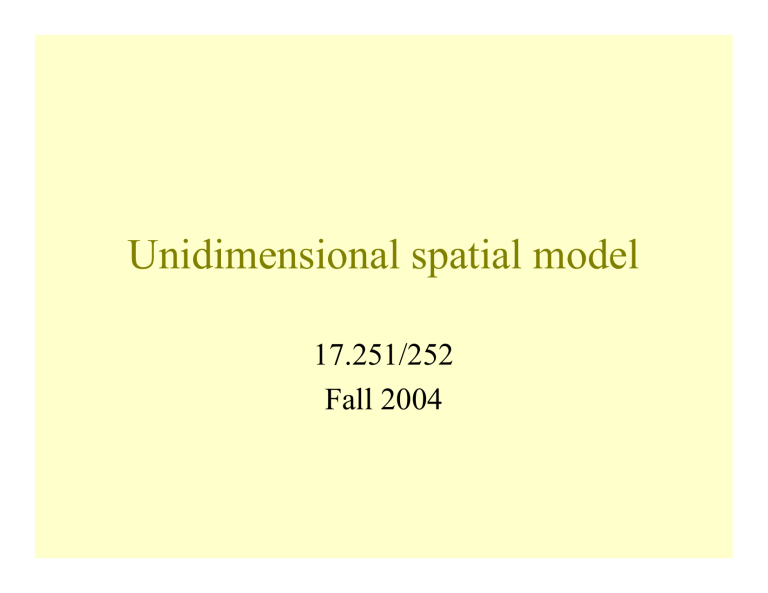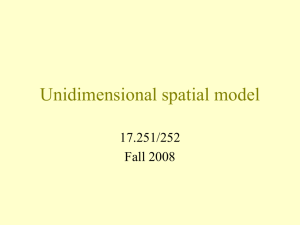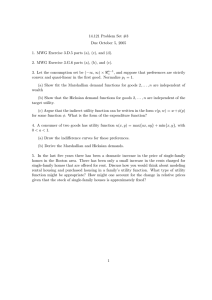Unidimensional spatial model 17.251/252 Fall 2004

Unidimensional spatial model
17.251/252
Fall 2004
Overall map
• Why do we care about theory or explanation at all?
• History of studying Congress
• Politics of Lineland
I.
Why do we care about theory or explanation at all?
• That’s what social scientists do
• That’s what politicians do
• That’s what citizens do
• Think about the current campaign and ideological polarization
Different professions have different ways of theorizing about legislatures
• Activists: good guys and bad guys
• Reporters: individual stories about good guys and bad guys
• Political scientists: The general, generic, and predictable
II.
Brief history of political science and
the refo re l egi slat ive
stu die s
• Early days to ~1880: formalism
• ~1800 to 1950: Progressive history
• 1950 to 1980: Sociology
• 1980 to the present: Economics
Formalism
Progressive history
• Wilson, inspired by Bagehot’s The English
Constitution
Sociology
• The group’s what’s important
• Congress is just a group
Economics
• The individual’s what’s important
• Collective behavior derives from individual behavior and interest
How each group would approach the congressional role in intelligence reform
• Formalism
– What does the Constitution say about the role of Congress and the Executive in intelligence?
• Progressive history
– Does the Constitution actually govern the exercise of intelligence?
How each group would approach the congressional role in intelligence reform
• Sociology
– Who are the actors and what roles do they play?
– What are the factors that constrain actors to stay within their roles?
• Economics
– Who are the relevant individuals and what are their goals? (Election, policy, power, etc.)
– What are the sets of strategic moves these individuals can make to optimize?
Advancements in legislative studies
• Our understanding of legislatures has become more precise over time
• Modern legislative analysis focuses on the interaction between individuals and institutions
– Without institutions, decisionmaking chaotic
– Heritability problem
• Theoretical primitives
– Preferences
– Rules
Logic of next step
• Begin with simple preferences
• How does decisionmaking proceed without institutions?
• How does decisionmaking proceed with institution?
• Add complexity and stir
III. The Politics of Lineland
Though it is rare for a sitting Supreme Court justice to become chief justice, she said, Bush might go for O'Connor because
"she doesn't pose a threat to Roe v. Wade," the 1973 decision legalizing abortion.
Bush might like the idea of having O'Connor, the swing vote on the court, as chief justice for just two to three years, after which she likely would retire -- giving the Republican president another crack at altering the court's makeup,
Totenberg said.
From The Buffalo News, May 16, 2002, p. b4.
In seven years on the Supreme Court, Justice Anthony M. Kennedy has been neither ideological leader nor political strategist. His writings have drawn little attention from law reviews, and it is part of court lore that he's so little known a group of tourists once asked him to take their picture.
While Kennedy may lack the bold personality or compelling background of other justices, he has earned one important distinction: On a closely divided court, he holds the decisive vote.
Along with Justice Sandra Day O'Connor, Kennedy will be the justice to watch as the court in the weeks ahead decides major cases involving free speech rights, the separation of church and state and the constitutionality of government policies based on race. More often than O'Connor, however, it is Kennedy who casts the fifth -- and deciding -- vote and in recent years he has been in the majority on important cases more than any other justice.
Many of Kennedy's prominent "fifth votes" have led to liberal rulings. But Kennedy is overall a conservative jurist, refusing to expand the role of the courts in American life and believing social policy is best left to elected officials.
From Washington Post, June 11, 1995, p. a2
First days of spatial voting theory
• Harold Hotelling’s “grocery store problem
L
Downsian model of party competition
R
Duncan Black and committees
Justice
Ginsberg
Abortions free and easy
Justice
O’Connor
Abortions regulated
Justice Thomas
Abortortionists jailed
• Preferences
• Alternatives
• Rules
More formally
Preferences
• Dimensionality (1,2,many)
• Location and characteristics of preferences
– Ideal points
– Utility curves
Repress Gay marriage Require
Different utility curves
Quadratic utility curve Linear utility curve x i
Gay marriage
U i
= (x i
– x) 2
Asymmetrical utility curve x i
Gay marriage
U i
= |x i
– x|
Non-single-peaked utility curve
Gay marriage Gay marriage
Alternatives
• Plain English: motions, amendments, etc.
• Expressed in same coordinate system as preferences
• Heresthetics : The art/science of trying to alter the dimensionality of a policy debate
– Clinton impeachment (private sex vs. perjury)
– 9/11-related detainees (civil liberties vs. security)
– Framing of Bush/Kerry campaign
Framing of Bush/Kerry campaign
Decisiveness
Kerry
Bush
America
Bush
“Sensitivity” in the war on terrorism
Kerry
America
Reversion point or status quo ( N )
• Most important alternative
• Taxing vs. spending: different reversion points
• Public schools in Pacific N.W.
$ t t 1
Rules
• Majority requirement
– Simple
– Supermajority
• Agenda-setting process: which alternatives get considered in which order
• Pure majority rule: the frictionless plane of social choice
Median voter theorem
IF
The issue is unidimensional
Voters decide based on their preferences
Preferences are single-peaked
Voting proceeds under pure majority rule
The median voter’s ideal point will prevail
Symmetry doesn’t matter
Violence against Iraq
Single-peakedness matters
Violence against Iraq
C B A
Lack of single-peakedness in picking capitol
Capital example
Penn. del
N.J. del.
Annapolis Dover Phil.
Geographic location
Trenton
Important corollary to median voter theorem:
Under the same conditions that produce the median voter result (except that preferences are symmetrical), if a committee or electorate is given the choice between two alternatives, the one closer to the median will prevail.
[The median is a dictator]
Supreme Court Replacement
Example
Who is the median in Congress?
(2003 version)
?
House
DD I DDDDDDDDDDD RRRRRRRRRRRRRRRR
Senate
DD I DDDDDDDDDDD R RRR D RRRRRRRRRRR
Source: Keith Poole, http://voteview.uh.edu/recentpolitics.htm




